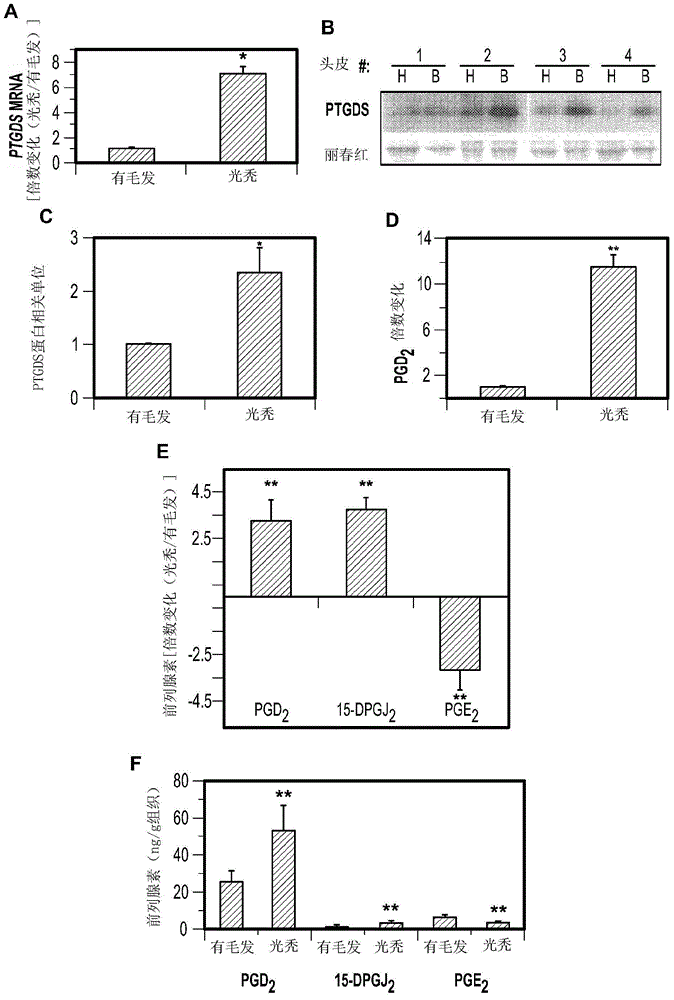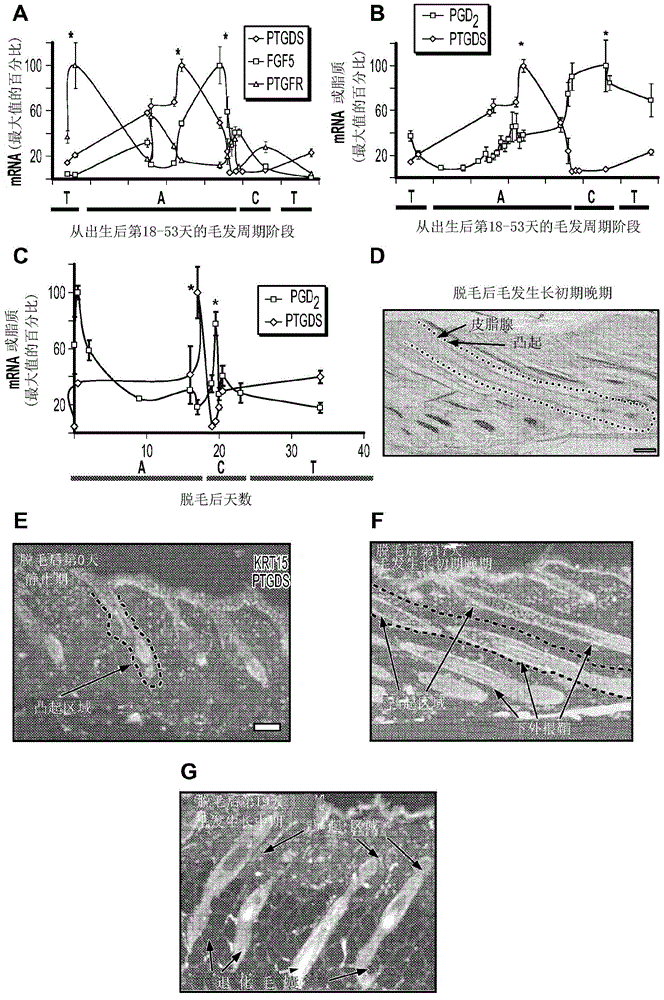Compositions and methods for regulating hair growth
A technology of hair growth and composition, applied in the field of hair growth regulating composition, capable of solving problems such as identifying active targets of minoxidil
- Summary
- Abstract
- Description
- Claims
- Application Information
AI Technical Summary
Problems solved by technology
Method used
Image
Examples
Embodiment 1
[0147] PTGDS and PGD2 are elevated in bald scalp
[0148] To assess total gene expression changes in the bald scalp of men with AGA, we performed gene expression microarrays in 5 men with AGA, comparing bald scalp to hairy scalp. The correlation coefficients between replicates with hairy scalp and between replicates with bald scalp were close to 1 ( figure 1 A). The intra-individual correlation coefficient for haired versus bald scalp was also close to 1, indicating the advantage of paired samples as internal controls. We identified 250 transcripts that were differentially expressed in human hairy versus bald scalp. As evidence of the validity of these transcripts, the clustering algorithm classifies samples as hairy or bald based on the expression of these genes ( figure 1 B). Hair keratin was upregulated in the haired scalp, as expected. For unclear reasons, hemoglobin-related transcripts are elevated in bald scalp. In haired scalp, 169 genes were elevated, and 81 ...
Embodiment 2
[0151] Non-permanent hair follicle mouse keratinocytes express Ptgds at the end of anagen
[0152] To better understand the normal biological function of Ptgds and PGD2 on hair growth, we took advantage of the well-characterized, synchronized hair cycle in mice. Fluctuations in gene expression and protein levels could be traced to different stages of the hair follicle cycle by examining the skin at different ages or after depilation of mouse hair, which induces a synchronized new hair follicle cycle. In the course of studying the characteristics of the synchronized mouse hair cycle, we demonstrated the phase of the hair cycle relative to postnatal (PN) days in mouse skin biopsy samples. We are confident that the histological features of mice at PN21 are those of late telogen, PN35 late anagen, and PN46 catagen, as suggested by macroscopic appearance. As measured by qPCR, Ptgds mRNA peaked in the late phase of anagen and was 7-fold higher than the telogen (telogen) phase of ...
Embodiment 3
[0156] Expression of PTGDS in non-permanent keratinocytes of human hair follicles
[0157] In normal terminal human hair follicles, we found a similar presence of PTGDS, mainly in non-permanent hair follicles below the arrector pili muscle ( Figure 4 A). However, staining is variable, and many normal human hair follicles exhibit minimal or no staining ( Figure 4 B). This is consistent with lower PTGDS mRNA levels in haired versus bald scalps, and may also reflect a lack of synchrony in the human hair follicle cycle. In the miniaturized hair follicles of the bald human scalp, outside the bulge ( Figure 4 , C and E) and in some cases inside the upper base bulge ( Figure 4 D) Sebaceous gland and follicle keratinocytes express PTGDS. We also detected PTGDS outside the hair follicle epithelium, indicating a potential source of PGD2 in the dermis ( Figure 4 , E and F). In hair follicles undergoing catagen, PTGDS is present in mast cells within the fibrous band, the for...
PUM
 Login to View More
Login to View More Abstract
Description
Claims
Application Information
 Login to View More
Login to View More - R&D
- Intellectual Property
- Life Sciences
- Materials
- Tech Scout
- Unparalleled Data Quality
- Higher Quality Content
- 60% Fewer Hallucinations
Browse by: Latest US Patents, China's latest patents, Technical Efficacy Thesaurus, Application Domain, Technology Topic, Popular Technical Reports.
© 2025 PatSnap. All rights reserved.Legal|Privacy policy|Modern Slavery Act Transparency Statement|Sitemap|About US| Contact US: help@patsnap.com



